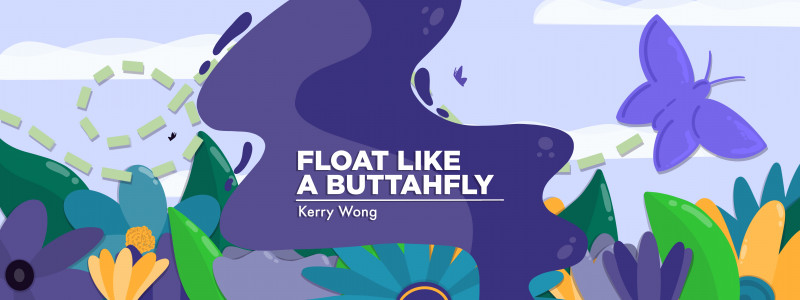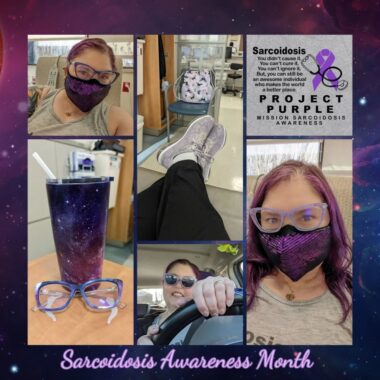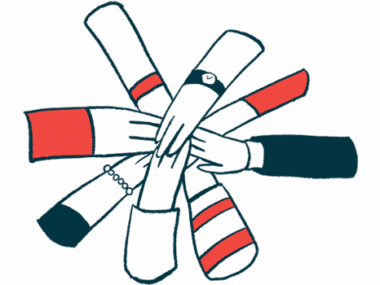The power of purple during Sarcoidosis Awareness Month
How we can make a difference by concentrating our efforts at outreach
Written by |

“Sarc-a-what?”
That’s usually the response we get when we tell someone we have sarcoidosis. “What’s that?” they ask, and then tune out the long explanation we begin to give. “Oh, good,” they add, “at least it’s not cancer.”
And that’s precisely why we need Sarcoidosis Awareness Month.
Throughout April, we proudly purple-fy ourselves with clothing, accessories, makeup, and even hair. We share purple ribbons and post purple pictures everywhere we can. The goal is to draw attention, to say, “Look at me.”

On her first infusion day during this year’s Sarcoidosis Awareness Month, Kerry shows plenty of purple. (Courtesy of Kerry Wong)
But looks aren’t all we need.
We need to be asked questions that we can answer. “Why are you wearing so much purple?” “What is sarcoidosis?” “How does it affect you?” “What are they doing to treat it?” “How are you dealing with it all?”
It’s only through these questions, these real conversations, that we can truly raise awareness. These exchanges are how people can begin to understand that sarcoidosis is more than just “not cancer.”
Ironically, I’m writing this from my hospital’s cancer center, where I get weekly intravenous immunoglobulin (IVIG) infusions to treat sarcoidosis-associated small fiber neuropathy. Every Tuesday, I spend eight hours here, hooked up to a machine. Every Wednesday, I spend most of the day sleeping or in a half-sleep trance. I lose two days a week, but they make the other five more bearable.
Breaking the cycle
We also need answers to the important questions we still have. “What causes sarcoidosis?” “Why are some people severely affected while others have no symptoms?” “What determines which type(s) of sarcoidosis someone gets?” “How can we do better at diagnosing and treating it?” “Is there anything we can do to prevent it?”
That’s where research comes in, and there just isn’t enough being done. It’s a self-perpetuating cycle for rare diseases, where research isn’t done because there isn’t funding because no one’s heard of it because research isn’t done.
But this is where Sarcoidosis Awareness Month can make an impact. If we can infuse a bit of fundraising and a bit of attention to slow that cycle, it can lead to the research needed to answer some of those questions.
Still, cancer seems to be the universal “we know this is bad” disease, with which all others are compared. But it’s not a competition, and if it were, it’s not a fair one. A “fair” comparison would have to consider that:
- Both sarcoidosis and cancer can affect people of any age, gender, or ethnicity.
- Both sarcoidosis and cancer can affect any organ or system in the body.
- Both sarcoidosis and cancer can cause a wide variety of symptoms and severities.
- Both sarcoidosis and cancer need more research, better treatments, and cures.
- Both sarcoidosis and cancer can be scary when diagnosed and even years later.
And when it comes to the people who love us, both sarcoidosis and cancer can make them feel helpless.
But this is where Sarcoidosis Awareness Month can be the most transformative. Though we can (and should) raise awareness all year long, this month prompts the greatest concentration of that effort, making us – and our condition – more visible to all, including our friends, colleagues, and loved ones. Now it’s up to us to show them what we need them to see.
When sarcoidosis affects our hearts, lungs, nervous system, or joints, it can be what’s called an “invisible illness.” We may appear healthy on the outside, no matter how unwell we truly are. That’s why we’re so often told “you don’t look sick” by well-meaning but misguided acquaintances.
When we say “look at me” with our purple hair and accessories, we’re taking advantage of an opportunity. While we have your attention, we can share our experiences: what we feel physically, how we’re limited by this disease, how that makes us feel, and what we need from others. And it’s an opportunity for our friends, colleagues, and loved ones to say, “I’m here with you, and I’m here for you.”
As we continue to raise awareness in person and online, locally and worldwide, we’re also sending an important message to sarcoidosis warriors around the world.
From the time of our diagnosis through our initial Google search for information, it’s easy for us to feel lost, isolated, and overwhelmed. It can feel as though we have no one to talk to who understands. How can we expect anyone to “get it” when even the doctors and researchers don’t fully understand this disease?
But even if we don’t understand the science, we can understand and empathize with each other.
During Sarcoidosis Awareness Month, we fly our purple flags high for all the world to see. In doing so, we’re shouting, “Here we are!” to the global sarcoidosis community. We’re here, and you’re not alone.
Note: Sarcoidosis News is strictly a news and information website about the disease. It does not provide medical advice, diagnosis, or treatment. This content is not intended to be a substitute for professional medical advice, diagnosis, or treatment. Always seek the advice of your physician or other qualified health provider with any questions you may have regarding a medical condition. Never disregard professional medical advice or delay in seeking it because of something you have read on this website. The opinions expressed in this column are not those of Sarcoidosis News or its parent company, Bionews, and are intended to spark discussion about issues pertaining to sarcoidosis.







Leave a comment
Fill in the required fields to post. Your email address will not be published.